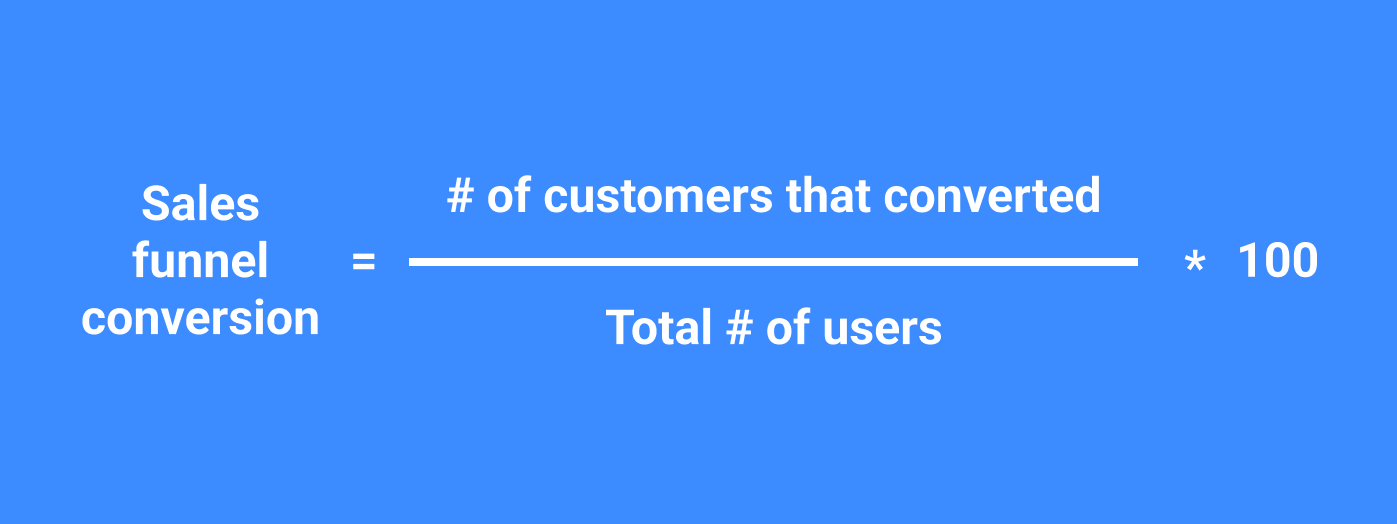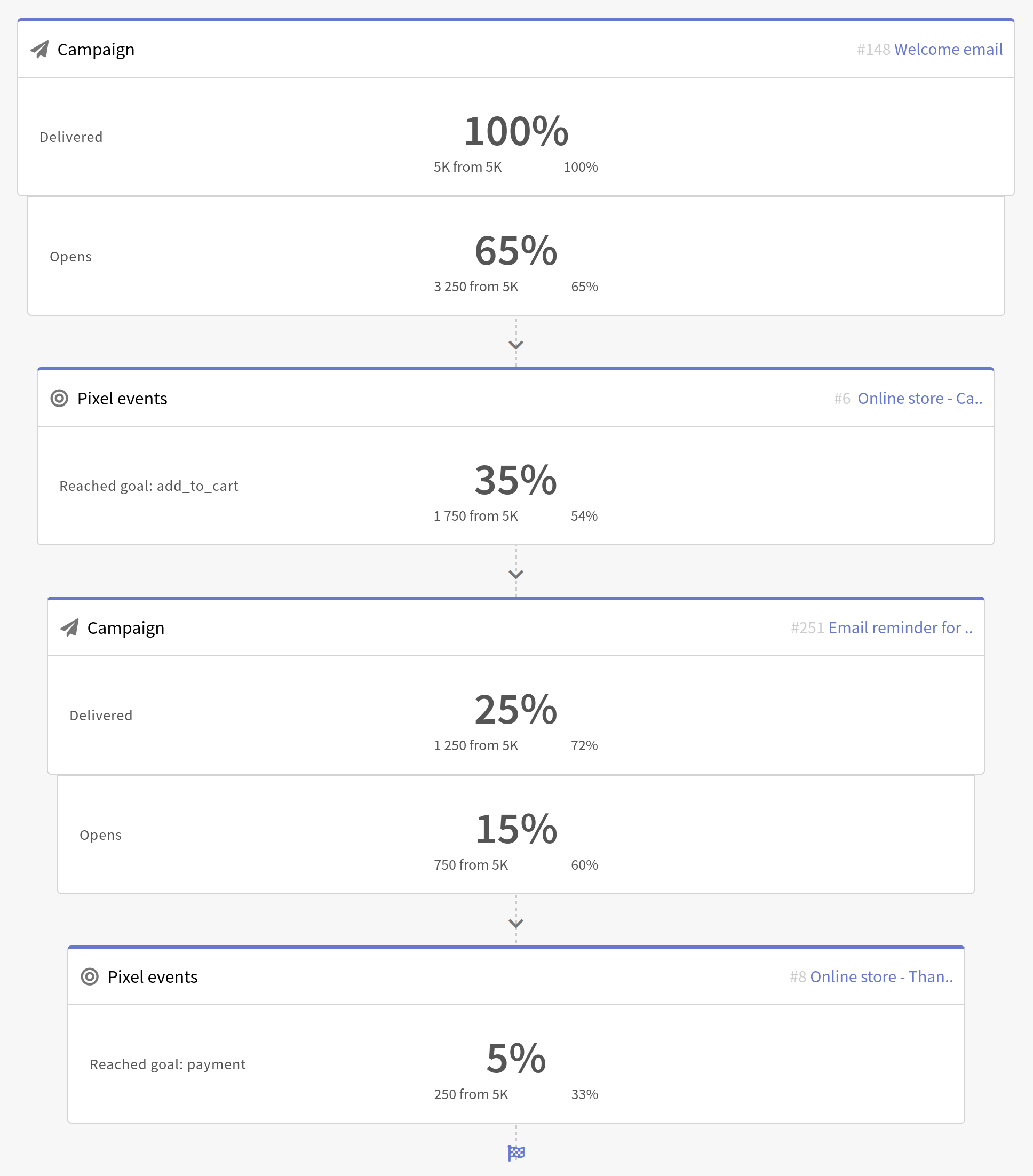Sales Funnel: Definition, Models and Stages

Customers do not always buy as soon as they find a product on a company's website or elsewhere. When it comes to complex and expensive products, consumers take the time to compare and study. For this reason, companies try not to be intrusive and help users go through all stages of decision making step by step.
It is a sales funnel that is used to make the process transparent and simplify analytics. A sales funnel is a concept that describes all the steps a customer takes on the way to a conversion. There are several funnel models: the classic five-step buying scheme, the AIDA model, the SPIN method, and others. The company chooses a model and adapts it to its needs or creates its own version.
In this post, we will explain what a sales funnel is, why use this concept and how to develop it.
What is a sales funnel and why use it
A sales funnel, also known as a marketing funnel, is the journey a customer takes from first contact with a business to making a purchase. The model is usually visualized as an upside-down cone and represents all the stages of sales that the client goes through. The top part gets the most leads. But not everyone gets to the end where the purchase takes place, so the cone narrows to the bottom.
Why does your business need a sales funnel
- Highlight weak spots. When all steps are written and all stages of the sales funnel are tracked, it is easy to analyze and understand where there is a problem in sales.
- Supervise the work of sales reps and marketers. The funnel includes marketing tools and sales activities, so it is easy to track the effectiveness of each participant in the process.
For example, your advertising campaign results in 100 applications per week, but only 5-10 people buy. The analysis shows that the applications are targeted, and most of all clients are “turned back” after talking with the manager. You look into the situation and find that sales reps are not interested in dealing with the client and do not know how to handle objections about the high price. If the company did not have a sales funnel, it would be more difficult to find the reason.
- Create controlled sales. If you know at what stage of decision-making the lead is now, you can make an offer that will satisfy their needs. This approach will speed up the purchase.
- Analyze sales performance. You can calculate your sales funnel conversion using the formula. Divide the number of converted customers by the total number of users, and then multiply the result by 100%.

In other words, this is the difference between the number of leads at the top and the bottom. The more potential customers reach the purchase, the better the funnel works.
Sales funnel stages
The classic sales funnel is the AIDA model, which consists of four stages.
| Stage | Description |
|---|---|
| Attention | The lead contacts the brand for the first time through advertising or direct search on the Internet. |
| Interest | The lead is interested in the product, for example, they subscribe to the newsletter, click on the links or ask questions. |
| Desire | The lead understood that he needs the product, and now they are looking for options for a profitable offer, such as discounts, free shipping, etc. |
| Action | The lead places an order. |

The other type is the marketing funnel, which repeats the five stages of sales.
| Stage | Description |
|---|---|
| Approaching the customer | The first contact between a sales rep and a potential client or automatic first message. It is important to make the right impression and motivate a person to continue communication. |
| Discovering customer needs | The sales rep asks the client questions about their needs. Then the manager draws a conclusion and offers a suitable solution. |
| Pitching | Present your solution. Based on the discovered needs of the client, talk about the features of the product and its benefits. The sales rep presents only those features that are important to the client. |
| Handling objections | The sales rep answers the buyer's questions and works out objections. For example, doubts about the cost or quality of the product. |
| Closing the deal | The customer is ready to buy and is interested in payment methods or installments. The task of the sales rep is to switch the client to the completion of the purchase: pay, order delivery, and so on. |
In brick-and-mortar retail stores, all five steps are done in a conversation here and now. However, if your company operates in the digital space, the online sales funnel consisting of such stages is not always fast. Sometimes the process includes phone calls, messaging, and sending files.
Another option is the SPIN method. Its author, Neil Rackham, said that classic five-step sales models are not effective for large and complex deals, such as B2B. According to SPIN, at each stage managers work with different types of questions that identify the customer's problem, clarify and lead to a purchase.
| Stage | Description |
|---|---|
| Situation | Open-ended questions to clarify the situation in which the customer is now. |
| Problem | Questions to identify problems and hidden needs. |
| Implication | Questions that demonstrate the possible negative effect if the problem will not be solved. |
| Need-payoff | A type of “what if” question that guides the customer into the future; questions like these show how a customer's life would change if they fixed a problem with your product. |
Each company chooses the model that best suits its needs, and transforms the stages, adjusting them to the business processes.
How to build a sales funnel
There are no universal methods, so brands not only adapt existing marketing funnel models for themselves, but also develop their own. Some models also include after-sales service, upselling and cross-selling.
Let's create a custom sales funnel in six steps:
1. Collect data
Collect information about the audience that should be included in the list of leads. Determine the channels through which customers come. Find out how customers behave on different resources, as well as what their needs and objections are. Next, plan a funnel for a specific audience, and not for all customers at once. Choose one of the existing models, exclude the steps that are not important for your company and add the missing ones.
2. Define a goal for the funnel
Specify what conversion rate you would like to receive from the funnel and also rates for intermediate stages. The model is divided into top, middle and bottom. Specify how many users are expected to reach each stage.
3. Think through the steps of the funnel
Define actions at each funnel step. For example, at the beginning it may be the launch of an advertising campaign. The middle is a call from the sales rep or an email reminder of the purchase. At the end, you can offer free shipping or bonuses.
4. Create content for each step
For automatic funnels, the content can be email templates. If sales reps lead customers through the funnel, prepare scripts, materials that they will send to customers for a detailed acquaintance with the product.
5. Set up a sales funnel
Marketing funnel can work:
- manually through the sales staff;
- semi-automatically — email marketing services, phone services and other automation platforms are responsible for some of the stages;
- automatically — a marketer only controls and optimizes.
You will have to use special services to set up semi-automated and automated sales funnels. In the future, this will save time for your employees and speed up communication with the client.
6. Run the funnel, analyze and optimize
Once the funnel is up and running, it is important to monitor and improve it. Regularly measure performance at each stage and quickly respond to changes. Only in this way the model will bring the expected income. To optimize your funnel, you need to get feedback from users on the sales process and analyze the stages of the funnel.
Sales funnel example
The user visits your site, adds the item to the cart and immediately checks out. This is an example of a simple funnel, but this rarely happens. Often the path to purchase is longer and more difficult. Here is an example of such a funnel.
The user:
- Gets to the company's website through contextual advertising.
- Views a product, for example, an autumn jacket.
- Subscribes to an email newsletter that informs about promotions and brand news.
- Receives an email with an offer for the autumn collection.
- Follows the link and adds the item to the cart, but does not check out.
- The company sends a reminder email about the product in the cart and the user buys.
How to automate your sales funnel using Altcraft Platform
The platform supports omnichannel marketing, so it collects information about different stages of the sales funnel in a single profile. Let's take a look at how to automate the customer journey from the example above.
- You set up and run contextual advertising through Google Ads.
- Jane visits your site and leaves her email. Her contact details are included in the Altcraft Platform database. The subscription to the resource is added.
- The platform launches an automatic series of welcome emails.
- Jane receives an email with a promotional code. She reacts and adds the item to the cart, but does not check out.
- Altcraft Platform starts an abandoned cart email scenario.
- Jane becomes interested and buys. The funnel ends.
The entire process of moving a user through the sales funnel is automated through workflows and other Altcraft Platform tools. Sending messages through different channels — Email, SMS, Push, WhatsApp or Telegram — can expand the possibilities of your business and make the customer journey completely clear and controlled.
 Abandoned cart scenario
Abandoned cart scenario
The Funnel report is used to track the process performance. The report displays metrics for all actions within the strategy. It is possible to visualize all the steps of the sales funnel: the number of customers and the percentage of conversion.
 Conversion funnel in Altcraft Platform
Conversion funnel in Altcraft Platform
Conclusion
A sales funnel is a model of a customer's journey from the first meeting with a brand to purchase. Using this approach, you will make sales transparent and controlled. The company begins to control each stage of the transaction, monitor the work of the sales department and find weak spots.
Building a sales funnel is possible using the AIDA, SPIN models, five classic sales steps and others. There is no universal solution, so companies also create their own models. To do this, you need to collect customer data, define goals, make a plan for each stage, prepare content, set up a funnel, and continue to optimize after launch.
You might be interested in:
NFT allows one to sell and buy digital objects for cryptocurrency. It may soon replace documents in the real world.
Read moreFor those who plan to communicate with customers in the messaging app.
Read moreLet's explore different types of interactive emails and discuss how to start sending them.
Read more